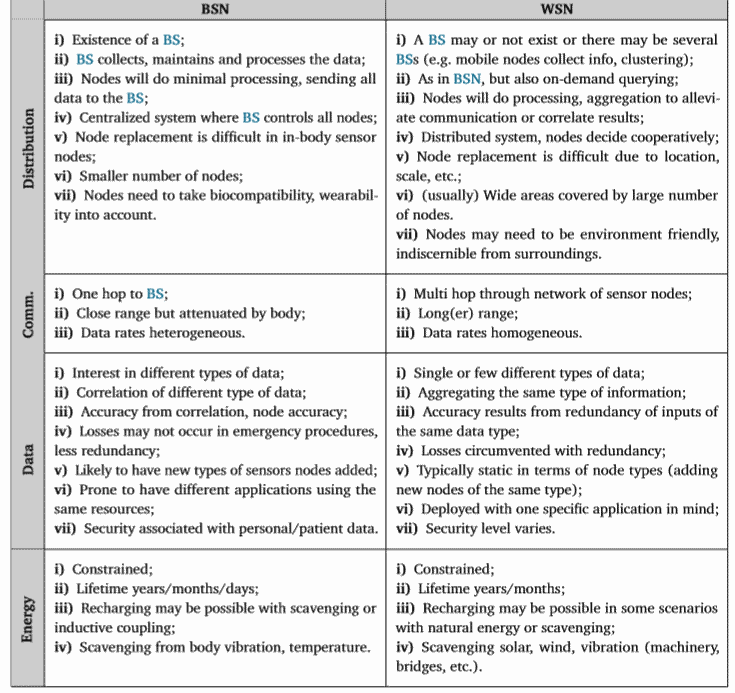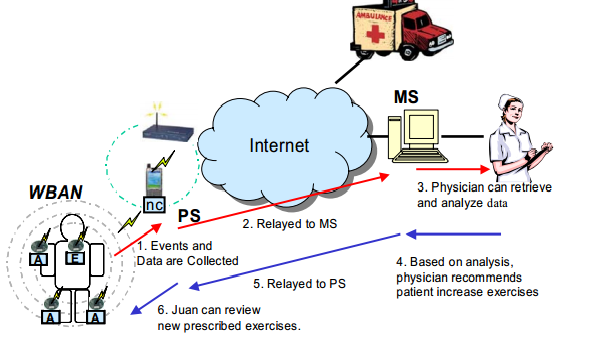
BANs (more specifically Body Sensor Networks (BSNs)) have similarities with WSNs, starting with having sensor nodes that form a network. However, there are several differences that make BANs prone to different problems, approaches and optimizations possibilities. Table 1 summarizes the differences and similarities.

This is a hypothetical case study to illustrate the usefulness of a WBAN based system. This illustrates how this system can be used to both address the problem and provide advantages over typical present day solutions.
Juan Lopez is recovering from a heart attack. After the release from the hospital he attended supervised physical rehabilitation for several weeks. His physicians prescribed an exercise regime at home. During the physical rehabilitation it was easy to monitor Juan and verify he completed his exercises. Sadly, when left to his own self-discipline, he does not rigorously follow the exercise as prescribed. He exercises, but is not honest to himself (or his physician) as to the intensity and duration of the exercise. As a result, Juan's recovery is slower than expected which raises concerns about his health prognosis, and his physician has no quantitative way to verify Juan's adherence to the program.
Our health monitoring system offers a solution for Juan. Equipped with a WBAN, tiny sensors provide constant observation of vital statistics, estimate induced energy expenditure, and assist Juan's exercise. Tiny electronic inertial sensors measure movement while electrodes on the chest can measure Juan's heart activity. The time, duration, and level of intensity of the exercise can be determined by calculating an estimate of energy expenditure from the motion sensors. Through the Internet, his physician can collect and review data, verify Juan is exercising regularly, issue new prescribed exercises, adjust data threshold values, and schedule office visits. Juan's physician need not rely on Juan's testament, but can quantify his level and duration of exercise. In addition, Juan's parameters of heart rate variability provide a direct measure of his physiological response to the exercise serving as an in-home stress test. Substituting these remote stress tests and data collection for in-office tests, Juan's physician reduces the number of office visits. This cuts healthcare costs and makes better use of the physician's time. In urgent cases, however, the personal server can directly contact Emergency Medical Services (EMS) if the user subscribes to this service. Figure 5 illustrates one possible data flow.
The applications described in the previous section indicate that a WBAN consists of several heterogeneous devices. In this section an overview of the different types of devices used in a WBAN will be given.
Wireless Sensor node:
A device that responds to and gathers data on physical stimuli, processes the data if necessary and reports this information wirelessly. It consists of several components: sensor hardware, a power unit, a processor, memory and a transmitter or transceiver. Sensors include:
a) Biosensors - For monitoring of vital physiological signs (oxygen level in the blood, heart
rate, body temperature ,rate of respiration etc).
b) Motion sensors - For collection of information about the current state of the patient's body (walking, running, standing, sitting, falling etc).
Wireless Actuator node:
A device that acts according to data received from the sensors or through interaction with the user. The components of an actuator are similar to the sensor's actuator hardware (e.g. hardware for medicine administration, including a reservoir to hold the medicine), a power unit, a processor, memory and a receiver or transceiver.
Wireless Personal Device (PD):
A device that gathers all the information acquired by the sensors and actuators and informs the user (i.e. the patient, a nurse, a GP etc.) via an external gateway, an actuator or a display/LEDS on the device. The components are a power unit, a (large) processor, memory and a transceiver. This device is also called a Body Control Unit (BCU), body gateway or a sink. In some implementations, a Personal Digital Assistant (PDA) or smart phone is used.

While progress has been made in the areas of wearable sensors and WBANs, more work is needed in (a) information infrastructures that facilitate remote storage and viewing of patient data as well as access to external processing and analysis tools via the Internet, (b) the development and use of interoperability standards that promote information exchange, plug-and-play device interactions, ease of use, and reconfigurability, and (c) system and device-level security functionality that will ensure data integrity and limit access to patient-identifiable information.
Some of the issues are listed below
BAN sensor nodes: To better monitor a human's vital signals, behaviour, and the surrounding environment, a wide range of commercially available sensors can be deployed, such as accelerometer and gyroscope, as well as traditional medical sensors including electroencephalography (EEG), electromyography (EMG), electrocardiogram (ECG), blood pressure, pulse oximetry (SpO2), respiratory inductive plethysmography (RIP), carbon dioxide (CO2), and so on. Recent technological developments have enabled sensor miniaturization, power-efficient design and improved biocompatibility. Issues related to systems integration, low-power sensor interface, and optimization of wireless communication channels are active research fields.
Physical layer Issues: The characteristics of the physical layer are different for a WBAN compared to a regular sensor network or an ad-hoc network due to the proximity of the human body. Several researchers have already started studying the propagation of electromagnetic waves in, and on the body and a few models for the physical layer are proposed. It should be noticed that a patient's body shape, position and movements of the body can have a severe impact on the received signal strength. Further, new emerging technologies such as galvanic coupling and transformation of information via the bones offer promising results and need to be investigated more thoroughly.
Data Link and Network Layer issues: Although some protocols already exist that take care of the data link layer and networking, this area still has a lot of open research issues. On the data link layer, more WBAN specific MAC-protocols need to be developed that take into account the movement of the body, i.e. the mobility of the nodes, additional low-power features such as an adaptive duty cycle for lowering the idle listening and overhearing, the use of the human physiology such as heart beat to ensure time synchronization and so on. For the network layer, a promising research track is the combination of thermal routing with more energy-efficient mechanisms.
Material for sensors/actuators: As sensors/actuators are going to be put on human bodies or even implanted, their size, form factor, and physical compatibility to human tissues are crucial. This motivates the search for and synthesis of novel materials.
Power supply issues: As all WBAN devices require an energy source for data collection, processing, and transmission, development of suitable power supplies becomes paramount. Most WBAN devices are powered by batteries, which may not even be replaceable in cases where the devices are implanted in the human body; thus, techniques like remote battery recharging are important. In a full active mode a node can't operate more than a month because a typical alkaline battery provides about 50 watt-hours of energy. Any commercial applications have to guarantee that all the devices will work for at least a year without any maintenance / replacement. The developers have to design better scheduling algorithms and power management schemes to deal with these power issues.
Computation: Due to both limited power as well as memory, computation should also be limited. The biosensors cannot perform large bit computations due to lack of enough memory. Unlike conventional wireless sensor network nodes, biosensors do not have much that computational power. Since communication is vital and memory is low, little power remains for computation. A solution is that some sensors may have varying capabilities that communicate with each other and send out one collaborative data message.
CONCLUSION
In this report the role of WBAN in improving human Quality of life has been investigated. All technological trends and the ability to measure a wide variety of physiologically important signals indicate that WBANs are well positioned to become a key component in providing continual, unobtrusive, and affordable monitoring in healthcare. The large amount of data collected through these services can also be utilized for knowledge discovery through data mining. Thus a WBAN-PS-medical server infrastructure could significantly contribute to monitoring and studying of drug therapy effects.
The convergence of low-power wireless communication standards, plug-and-play device buses, off-the-shelf development kits for low-power microcontrollers, handheld computers, electronic medical records, and the Internet can provide a more patient-centric care model, where ad-hoc collections of devices could be assembled on the fly by a physician, care provider, and/or patient to create monitoring systems matched to patient needs. It has the potential to shift the paradigm of healthcare from reactive to proactive, from disease management to disease prevention.
A WBAN is expected to be a very useful technology with potential to offer a wide range of benefits to patients, medical personnel and society through continuous monitoring and early detection of possible problems.